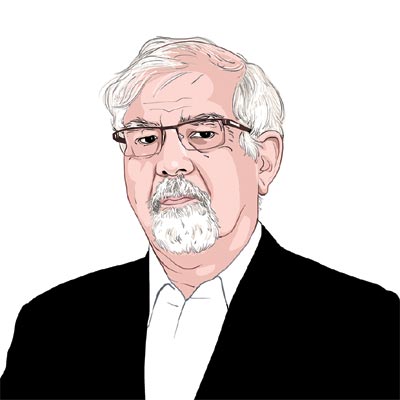Opinion The grand illusion of zero growth
In this era of a no-bail attitude to corruption,what about intellectual corruption?
The Congress-led UPA 2 has just announced the implementation of yet another of its trademark bankrupt policies: the implementation of a caste census for the first time since 1931 and the authorisation of the ministry of rural development to conduct a census of families below a new seven-parameter poverty line a poverty line that would replace the existing poverty line of Rs 15 and Rs 20,per person per day,in rural and urban areas,respectively. I will try and document the intellectual and other dishonesties that are so pervasive in Indias definition of the poor and policies towards the poor.
The first indication that something is massively wrong with Indias battle against poverty is that there is no other country,either in the past or in the present that has conducted itself in quite the same (dishonest) manner. Poverty is not exactly a newfound problem,though of late the Indian poverty industry looks much more like the lobby of corrupt cigarette manufacturers. It is fighting for protection against extinction.
High growth in China,India and even Africa,has meant that the world has changed drastically since the World Bank coined the slogan that it dreamt of a world free of poverty. Yet,curiously,after each decade of high growth,the proportion of World Bank poor has stayed constant at around 25 to 30 per cent. In 1987,according to its calculations,28.7 per cent of the worlds population was absolutely poor; in 2005,the proportion of world poor: 25.2 per cent. During the same period,per capita incomes in the entire developing world nearly doubled! Yet poverty stayed the same? How come? Because,while ostensibly keeping the poverty line constant in real terms,the World Bank inadvertently increased it by close to 60 per cent.
This is how dishonesty is practiced by increasing the absolute poverty line. There is every reason to increase the absolute poverty line and I believe that it should be further increased by about 20 per cent but one should at least be honest about it. If the World Bank were to be honest,then it will turn out that overall growth does reduce poverty,that the Millennium Development Goal of reducing poverty by half between 1990 and 2015 was achieved more than a decade before the target date,and that absolute poverty as we know it is,joyfully,in terminal decline.
Most developing countries,especially China,ignore the World Bank calculations. But not India,and especially not those who profit the most from the perpetuation of the myth of ever increasing,or not decreasing,absolute Indian poverty. According to the wrong and exaggerated World Bank measure of poverty for all countries,more than 40 per cent of the population in India was absolutely poor in 2005 (and,not so coincidentally,the same proportion was poor in 1983.) But our intellectuals,especially those who staff the soon-to-be-defunct Indian communist parties,and/or the National Advisory Council (NAC) headed by Congress president Sonia Gandhi,are ever more imaginative in their assessment of poverty in India and what is needed to redress it.
Why are our intellectuals so bankrupt? One leading NAC member,Jean Dreze,documents how the Congresss flagship anti-poverty employment program NREGA is a loot for work program; loot for the administrators of the program,the middlemen and politicians. His proposed remedy? A concentrated expansion of the programme propelled by the smug belief that since a Gandhian is involved,corruption would be eliminated.
Other fellow-travelling Indian intellectuals want to document that the poor are getting poorer,and as evidence,use the fact that the consumption of calories by the poor has barely increased,and perhaps even declined. That this is a historical worldwide pattern that is to be expected with a reduction in poverty is not relevant. This is dishonest: look at the food consumption of the poor. In 1983,the consumption of fruits and vegetables by the poor was 14 per cent of the consumption of fruits,vegetables and foodgrains; in 2004-05,this ratio had doubled to 28 per cent! In the West,and in Ireland,and in every rudimentary economics textbook,the discussion is about the change in consumption pattern from potatoes to meat (from more calories to considerably less calories and considerably more protein). But this pattern is an exploitation plot according to the intellectual luminaries at JNU.
Yet another NAC member,N.C. Saxena,feels that the public food distribution system (PDS) is plagued with corruption. After correctly documenting the corruption,he,not unlike Dreze,believes that expansion of the PDS system would considerably reduce,if not eliminate,corruption. And how does expansion of the food subsidy system decrease corruption? By making the right to food an act of Parliament! The same Parliament that has 143 out of 543 members with criminal cases against them; the same Parliament that passed the Emergency; and the same parliament that passed the employment guarantee act that Dreze correctly described as loot for work.
The intellectual corruption continues. A magazine normally known for well-documented investigative research against the establishment,Tehelka,feels compelled to state that the Indian poverty line of Rs 15 per capita per day in rural areas is too low to describe people as poor; it believes this poverty line is close to a starvation line. (Since the Indian poverty line is very close to the new enlarged World Bank line,Tehelka believes the World Bank is also practicing deception). As evidence,it provides interviews with several poor individuals. One such individual,Riaz Ahmad Batt,of Kashmir,a helper and cook at the local government high school states,Buying the basic,flour,rice, dal,sugar, tea,alone costs Rs 38 a day for my family of six. What happens in an emergency? According to Batt,very basic food costs Rs 6.30 per person per day but Tehelkas starvation line is Rs 15 per person per day. So rather than change the poverty line a la the World Bank,Tehelka conveniently changes a per-person expenditure to family (six-person) expenditure. What matters,when the goal is so noble of showing no progress for the poor,despite capitalist economic growth?
The author is Chairman of Oxus Investments,an emerging market advisory and fund management firm



